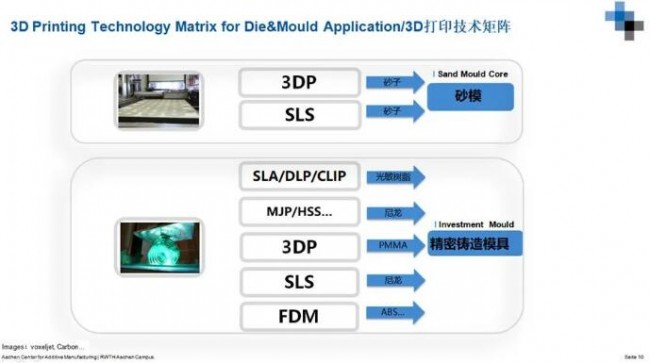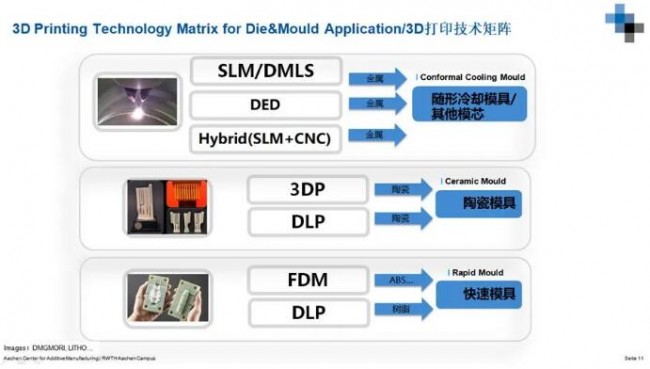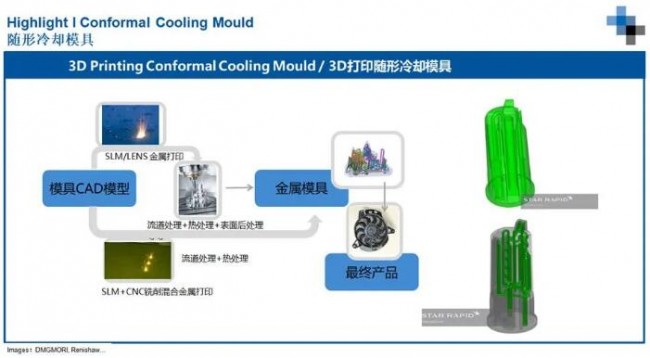Additive Manufacturing-3D printingOne of the significant advantages of technology is that parts are directly manufactured without the need for molds. With3D printingThe development of materials, the improvement of the quality control level of additive manufacturing,3D printingTechnology is developing from the manufacture of a small number of prototype products to the mass manufacturing of final parts. If you look at it from this perspective,3D printingTechnology and mold manufacturing technology seem to be a contradiction, and there is a substitute relationship between the two.
But at the same time, in the process of development3D printingRelying on its advantages in realizing complex structures and direct manufacturing without molds, the technology has been applied to mold manufacturing. These applications have played an important role in improving the comprehensive value of the mold’s full life cycle. Typical applications include metal3D printingManufacture of conformal cooling water channels for injection molds, and directly manufacture engine casting sand cores with binder injection technology.
indeed,3D printingThe delicate relationship between technology and mold “waste and stand” is developing. On the one hand,3D printingAchieve more complex and more value-added molds. On the other hand,3D printingThe advantage of “mouldless” of directly manufacturing products is “surpassing” the mould manufacturing process.learn3D printingThe application and development trend in the mold field, which requires3D printingHave an in-depth understanding of how the mold interacts closely.
3D printingImprove mold performance
![]() Each has its own merits3D printingtechnology
Each has its own merits3D printingtechnology
3D printingContains a variety of different technologies, which are respectively applied to subdivision fields such as conformal cooling molds, investment-precision casting, ceramic molds-precision casting, sand molds-gravity casting, and rapid molds.
 picture:3D printingApplication segmentation in the mold field
picture:3D printingApplication segmentation in the mold field
Applied to sand mold3D printingThe main technology category is 3DP-Binder Jet3D printingTechnology and SLS Selective Laser Sintering3D printingtechnology.
Investment mold3D printingThere are many types of technologies, including SLA/DLP/CLIP, the material is photosensitive resin; MJP/HSS, the material is nylon; 3DP adhesive injection3D printingTechnology, the material is acrylic (PMMA); SLS selective laser sintering technology, the material is mainly nylon; and FDM-fused deposition molding technology, the material is mainly ABS.
 picture:3D printingTechnology application matrix in the mold field
picture:3D printingTechnology application matrix in the mold field
Used to make conformal cooling molds3D printingTechnologies include selective laser melting of metals based on powder beds3D printingTechnology (LPBF) (including SLM/DMLS/EBM technology), DED directed energy deposition of metal3D printingTechnology, and mixed metals3D printingTechnology (usually based on CNC machining equipment).
Used to make ceramic molds3D printingTechnology includes 3DP-Binder Jet3D printingTechnology and DLP-Digital Light Processing3D printingtechnology. DLP-Digital Light Processing3D printingThe technology usually mixes resin materials and ceramic materials to print out, and then burns the resin materials through sintering, thereby leaving the ceramic materials to form ceramic products.
 picture:3D printingTechnology application matrix in the mold field
picture:3D printingTechnology application matrix in the mold field
Used to make rapid molds3D printingTechnology usually includes FDM-fused deposition modeling technology and DLP-digital light processing3D printingtechnology.In this regard, we may wonder, since3D printingCan directly manufacture plastic products, why need to pass3D printingHow about making quick molds made of plastic materials and then obtaining plastic products?The main reason for this comes from3D printingThe types of plastic materials are still very limited, especially in the product design verification stage, the real material manufacturing (ie3D printingThe plastic is the same as the plastic actually used for mass production), then in this case, in order to obtain the authenticity verification, you need to pass3D printingRapid mold to reduce the cost and cycle of mold manufacturing.
It’s worth noting that each3D printingEach technology has its own strengths and weaknesses, some have advantages in size, and some can achieve extremely detailed accuracy in surface accuracy. For example, the light curing process can achieve smooth and delicate details, which are applied to the lost wax casting of jewelry. Some have outstanding performance in terms of expansion rate. For example, when PMMA acrylic material is used as an investment mold, there will be no “shell expansion”.
 picture:3D printingConformal cooling mold
picture:3D printingConformal cooling mold
l Conformal cooling mold
Among them,3D printingIt is a typical application in the application of conformal cooling mold. During the injection molding process, cooling accounts for about 60% of the molding cycle, so the cooling cycle directly affects the production cycle to a large extent. The reduction of production cycle can greatly improve production efficiency, thereby saving investment in injection molding machine equipment, space and personnel. Significantly reduce manufacturing costs and increase the profitability of mold companies.
In traditional production and processing, the cooling pipes we use are horizontal and vertical. Many areas cannot be used as cooling pipes due to the limitations of existing processing technology, which greatly affects the final molding cycle and product quality. Conformal cooling adopts powder layer-by-layer sintering technology, which gives the freedom of design, allowing the pipeline to follow the shape of the product, so that the designer is no longer restricted by processing technology, and makes what you think is what you see becomes a reality.
Selective laser melting of metal based on powder bed3D printingTechnology (LPBF) is often used to process conformal cooling molds. The surface finish of these molds is critical because they will determine the appearance of the final injection molded part.Therefore, it is essential that3D printingMold inserts must have a very stable printing process to produce high-density parts, so as to achieve perfect surface finish after post-processing. These are3D printingThe most challenging requirements of the technology itself.
Another challenge for mold applications is related to the materials that can be processed by the additive manufacturing process. The powder bed-based selective laser melting of the metal3D printingTechnology (LPBF) is essentially a welding process. The materials commonly used in molds to reach a hardened state by quenching are not suitable for passage in most cases due to poor welding performance3D printingCome processing.exist3D printingIn mold manufacturing, metal materials that are not used for mold manufacturing but can meet the needs of molds are usually used. The most common material is maraging steel.
In this regard, metal powder suppliers are researching new materials in order to meet the specific needs of the mold (hardness, corrosion resistance, etc.), while still being able to carry out high-quality3D printing.
It is worth noting that3D printingThe conformal cooling mold inserts can also be used in the field of die casting. Generally speaking, whether it is injection molding or high pressure die casting, the combination of conformal cooling design and additive manufacturing usually simplifies mold design. By reducing the number of parts that need to be assembled (called assembly reinforcement), the need for sealing is eliminated or reduced. In particular, all injection molding shops have witnessed the consequences of seal failure and are well aware of downtime related to cooling leaks.
Currently using3D printingThe injection molding and high-pressure die-casting of mold inserts.3D printingThe technology used for conformal cooling mold manufacturing has matured.We will see more and more metals3D printingIt is no longer just used in the prototyping department, but in the production environment.
l Tire mold
According to the GF processing plan, in the field of tire mold manufacturing,3D printingThe technology has two levels of application: the first is the manufacture of complex tire molds, especially the steel sheet manufacturing in winter tires or snow tire molds that require high performance. This technology has been put into use in major tire mold manufacturers at home and abroad; the other The level is the integrated manufacturing of complex pattern molds, that is, there is no need to separately manufacture steel sheets and inlaid steel sheets. Although there are still application difficulties such as deformation and high cost, this application has great advantages in simplifying procedures and improving tire performance.
3D printingThe steel sheet still faces the problem of inlaying in the mold. At present, steel molds are mostly inlaid manually, that is, a steel sheet groove is processed in the mold cavity, and then the processed steel sheet is inserted manually. A small amount of steel sheets is not a problem in mold manufacturing, but a pair of winter tire molds often require thousands of steel sheets, and some specially designed tires even use more than 4,000 steel sheets.
Steel sheet inlay is still a very troublesome problem for mold manufacturers, especially with the increase in the number of steel sheets, the distance between the steel sheets is reduced, resulting in too small space and difficult to display. This problem is particularly obvious when the distance is less than 5-6mm.And through the metal3D printingThe technology directly manufactures a whole piece of complex pattern mold, which is expected to simplify the process and overcome the current problems in the inlay of steel sheets. In fact, there are many such attempts in the additive manufacturing industry, but most of them stay in the technical verification stage and are not mass-produced.
It is worth mentioning that, in this regard, GF processing plan proposes an additive manufacturing solution for printing pattern blocks. This plan consists of two specific improvement measures such as a special scanning strategy for pattern blocks and a differentiated layer thickness. In addition to meeting production requirements Manufacturers have high requirements for mold dimensional accuracy and surface finish, and at the same time, it can significantly shorten the processing time of a single pattern block, which provides an achievable industrialization path for the innovative process of pattern block manufacturing.
l Sand mold
3D printingIn terms of sand molds, the typical industrialization case is BMW.In order to meet the needs of lightweight and thermal management performance, BMW adopted3D printingTechnology to manufacture the foundry sand core of the S58 engine cylinder head. The turbo compressor and cooling pipeline of the S58 engine have been redesigned. The upgraded compressor and the indirect intercooler provided by the low-temperature circuit further enhance the power output of the S58 engine. The engine also integrates three radiators, as well as an independent engine oil cooler and independent transmission oil cooler.
BMW through innovative3D printingMold technology can be realized from model to product within 3-5 days. It can also realize the flexible and efficient production of key components of new energy vehicles through innovative processes, fixtures, tools, and the entire line of automated design.
In this regard, voxeljet-Voxel has adopted automation3D printingComplex sand molds and sand cores (called VJET X) provide integrated automated additive manufacturing solutions for the production of key automotive parts.
l Achievement and competition
But although3D printingAchieve more complex and precise molds, but due to3D printingCan directly manufacture plastic and metal products,3D printingThe substitution effect of molds is also on the rise.
In this regard, we need to understand,3D printingReplacement of injection mold.3D printingHow likely is it to compete with injection molding?Undoubtedly, the advantage of the injection molding process lies in large quantities, and3D printingThe advantage lies in small batches or for very complex designs. At present, to replace the injection molding process,3D printingThe room for development is either simple design in small batches, or very complex designs in large batches.and3D printingIf the technology wants to gain a place in the production process of small batches of simple products, it needs to be cheaper in terms of printing prices.3D printingIf the technology wants to obtain a greater advantage than the injection molding process in the production process of large-volume complex products, it needs faster printing speed.
On the other hand, we also need to understand,3D printingSubstitution of MIM metal injection molding, casting, die-casting and forging processes, due to3D printingThe development of technology is very rapid, and today3D printingSome technical disadvantages are quickly overtaken by the new advantages born tomorrow, and the manufacturing industry needs to keep an open attitude towards it.3D printingThe development of technology, mold manufacturers need to pay attention to at the same time3D printingAchieve complex molds and3D printingExceed the development of these two dimensions of mold to maintain competitiveness.
In addition, stones from other mountains can be used for jade. In the development process of an enterprise, in addition to strengthening its own innovative strength, seeking to combine with advantageous resources in the market is another way to accelerate development.Here, Fraunhofer Fraunhofer IPT Industrial Production Technology Institute, Fraunhofer Fraunhofer ILT Laser Institute, RWTH Aachen University of Technology and other additive manufacturing research fields concentrate their superior R&D resources in3D printingOn the one hand, through the Aachen Additive Manufacturing Center (ACAM), it connects the backbone of the field of additive manufacturing research and development, and provides manufacturing companies worldwide with the additive manufacturing expertise accumulated by leading European scientific research institutions over the years, helping companies deal with additive manufacturing. Challenges of technology in application.
(Editor in charge: admin)


0 Comments for “Leaping 3D printing technology results in better molds”